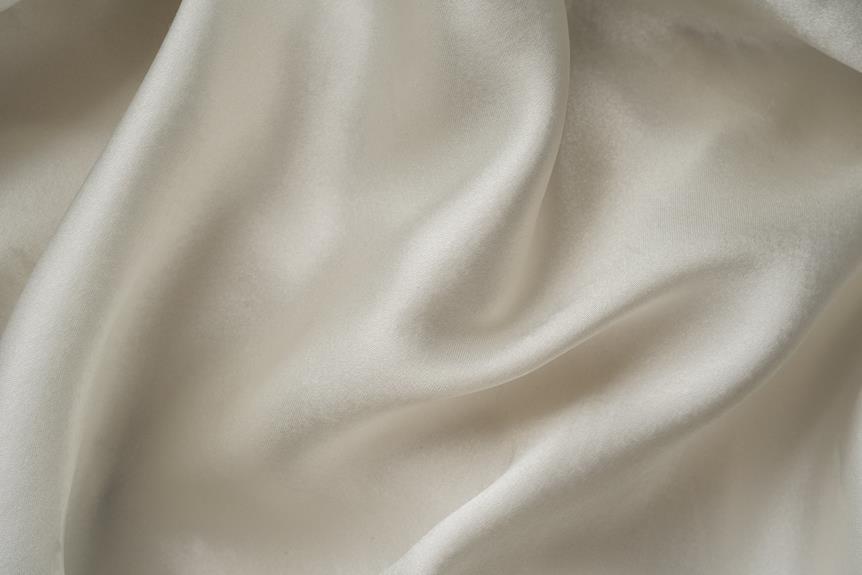Hey there, ever wondered if silk keeps you cool in the heat? Well, you're in luck, because we've got all the answers from a fabric expert.
In this article, we'll delve into the science behind silk's cooling properties, compare it to other fabrics, and explore what makes silk so breathable.
You'll also learn about the factors that affect silk's cooling effect and get some handy tips for choosing the perfect silk garments for warm weather.
Plus, we'll hear real-life experiences of people wearing silk in hot climates and get expert tips for maximizing silk's cooling benefits.
So, if you're looking to master the art of staying cool in silk, you've come to the right place.
Key Takeaways
- Silk's unique structure and natural breathability contribute to its cooling properties.
- Silk's fine and lightweight fibers help in moisture control and can absorb up to 30% of its weight in moisture without feeling damp.
- Silk is an excellent choice for managing perspiration and keeping you comfortable in hot and humid conditions.
- Choosing the right silk fabric, such as lightweight weaves like chiffon, and layering silk garments can enhance airflow and maximize the fabric's cooling benefits.
The Science Behind Silk's Cooling Properties
Silk's cooling properties can be attributed to its unique structure and natural breathability. The science behind silk's thermal regulation lies in its ability to regulate body temperature. Silk is a natural protein fiber that's extremely fine and lightweight, allowing it to drape beautifully while also allowing air to circulate around your body.
This natural breathability helps to wick away moisture from your skin, keeping you cool and dry in warm temperatures. Silk's moisture control is another key factor in its cooling properties. The fabric can absorb up to 30% of its weight in moisture without feeling damp, making it an excellent choice for managing perspiration and keeping you comfortable.
Silk Vs. Other Fabrics: a Comparison
When comparing silk to other fabrics, it's important to consider the cooling properties and breathability of each material.
Silk is known for its ability to keep you cool and comfortable, but how does it stack up against other popular fabrics?
Let's take a closer look at these key points to help you understand how silk compares to other materials when it comes to keeping you cool.
Silk's Cooling Properties
- Silk's natural fibers wick moisture away from the skin
- Silk's luxurious smoothness feels cool to the touch
- Silk's cooling properties make it a top choice for comfort and breathability in clothing.
Breathability of Silk
Compared to other fabrics, silk excels in breathability, ensuring optimal comfort in warm conditions. Silk's natural protein structure allows air to circulate, wicking away moisture and keeping you cool.
Unlike synthetic fabrics, which can trap heat and moisture, silk allows your skin to breathe, making it an excellent choice for heat regulation. This breathability also helps prevent the growth of bacteria and molds, keeping your skin fresh and dry.
In comparison to cotton, silk's breathability is superior, as it regulates body temperature more effectively. Additionally, silk's lightweight and airy feel contribute to its breathability, making it a top choice for warm-weather clothing.
When it comes to breathability and heat regulation, silk stands out among other fabrics, providing a luxurious and comfortable experience.
Understanding Silk's Breathability
When it comes to understanding silk's breathability, it's important to consider its natural ventilation and moisture-wicking properties. These are the key factors that contribute to silk's ability to keep you cool and comfortable, making it a popular choice for warm-weather clothing.
Silk's Natural Ventilation
To understand silk's breathability, focus on its natural ventilation, which directly impacts its cooling properties. Silk's natural ventilation is a result of its unique fiber structure, which allows air to flow through the fabric. This natural ventilation provides several benefits of silk, making it an ideal choice for warm weather clothing:
- Silk fibers are smooth and fine, creating tiny gaps between threads that enable air circulation.
- This airflow helps to wick moisture away from the body, keeping you dry and comfortable.
- The breathable nature of silk also prevents the fabric from sticking to your skin, promoting a cooling sensation.
Silk's natural ventilation not only enhances comfort but also contributes to its reputation as a cooling and luxurious fabric option.
Moisture-Wicking Properties of Silk
To experience silk's breathability and moisture-wicking properties, wear it in warm weather and notice how it keeps you cool and dry. Silk's impact on moisture management is remarkable. The structure of silk fibers allows for better air circulation, making it an excellent choice for staying comfortable in hot and humid conditions. Here's a comparison to illustrate silk's moisture-wicking abilities:
| Fabric | Moisture-Wicking |
|---|---|
| Silk | High |
| Cotton | Moderate |
| Polyester | Low |
| Wool | Low |
As you can see, silk outperforms other common fabrics when it comes to moisture-wicking. This is why silk garments can leave you feeling fresh and dry, making them an ideal choice for warm-weather attire.
Factors Affecting Silk's Cooling Effect
In order to understand how silk keeps you cool, it's important to consider the factors that contribute to its cooling effect.
Silk's breathability, which allows air to circulate close to the skin, plays a significant role in its cooling properties. This breathability is due to the natural protein structure of silk fibers, creating gaps between the threads that facilitate air flow, keeping you feeling comfortable and cool.
Additionally, silk's ability to regulate heat retention is another key factor in its cooling effect. Silk fabric has the remarkable capacity to adapt to your body's temperature, making it feel cool in warm weather by wicking away moisture and heat from your skin. This heat-regulating quality helps to prevent the buildup of excess heat, keeping you feeling fresh and cool throughout the day.
Imagine silk as a natural, breathable shield that allows air to flow freely and adapts to your body's temperature, providing a cooling sensation even in the warmest conditions. This combination of breathability and heat regulation makes silk an ideal choice for staying cool and comfortable.
Tips for Choosing Silk for Warm Weather
For choosing silk in warm weather, consider selecting a lightweight and breathable weave to maximize its cooling properties. When it comes to staying cool in silk during hot weather, the type of silk fabric you choose can make a big difference in your comfort. Here are some essential tips for choosing the right silk for warm climates:
| Consideration | Recommendation |
|---|---|
| Weave | Look for a plain weave or a loose, open weave such as chiffon to allow for maximum breathability. |
| Weight | Opt for lightweight silk fabrics like charmeuse or crepe de chine to enhance airflow and comfort. |
| Color | Choose lighter colors like white, pastels, or soft hues as they reflect sunlight and heat better than dark colors. |
| Layering | Consider silk garments that can be layered for versatility, allowing you to adjust to fluctuating temperatures. |
Real-Life Experiences With Silk in Hot Climates
Experiencing the breathability and comfort of silk in scorching hot climates can provide valuable insights into its cooling properties and suitability for warm weather wear. Real-life experiences with silk in hot climates have highlighted both the benefits and drawbacks of this luxurious fabric.
Consider the following scenarios:
- Imagine strolling through a bustling market in a tropical locale, feeling the gentle breeze on your skin as you wear a silk blouse. Despite the sweltering heat, the natural breathability of silk allows air to circulate, keeping you surprisingly cool and comfortable.
- The soft, lightweight nature of silk drapes elegantly, allowing for freedom of movement and preventing that sticky, clammy feeling often associated with synthetic fabrics in hot weather.
- On the other hand, picture yourself attending an outdoor event in a desert climate, clad in a silk dress. While the fabric's moisture-wicking properties help manage perspiration, its delicate nature requires extra care to avoid damage from sweat and prolonged exposure to the sun.
These real-life experiences underscore the potential of silk to offer cooling relief in hot climates, while also highlighting the need for mindful maintenance and consideration of specific environmental conditions.
Expert Tips for Maximizing Silk's Cooling Benefits
To maximize silk's cooling benefits, focus on choosing lighter colors and looser weaves in clothing. Lighter colors, such as white, pastels, or soft neutrals, reflect more sunlight, keeping you cooler than darker shades. When it comes to weaves, opt for looser options like silk chiffon or georgette instead of tightly woven silk satin. These looser weaves allow for better airflow, enhancing the fabric's breathability and maximizing comfort in warm weather.
When building your summer wardrobe essentials with silk, prioritize styles that provide ample ventilation. Look for pieces with features like open necklines, sleeveless or short sleeve designs, and flowing silhouettes that allow air to circulate around your body. These elements not only contribute to the overall cooling effect of silk but also add a touch of effortless elegance to your summer ensembles.
Another expert tip is to consider layering silk garments. Instead of wearing one thick layer, consider layering multiple lightweight silk pieces. This technique creates air pockets between the layers, which can further enhance the fabric's cooling properties while offering versatility in managing varying temperatures throughout the day.
Frequently Asked Questions
How Does Silk Compare to Other Natural Fibers in Terms of Its Cooling Properties?
When comparing silk to other natural fibers in terms of cooling properties, silk stands out for its ability to regulate body temperature and provide a cooling sensation. Its natural breathability and moisture-wicking properties make it a top choice.
Can Silk Be Worn in Hot and Humid Climates Without Feeling Overheated?
Yes, silk can be worn in hot and humid climates without feeling overheated. Its natural properties and breathability make it a great choice for staying cool in warm weather. It allows for airflow and wicks away moisture.
What Are the Best Ways to Care for and Maintain the Cooling Properties of Silk Fabric?
To maintain the cooling properties of silk, wash it by hand or on a gentle cycle in cold water. Avoid harsh detergents and wringing. Hang dry, and store it in a breathable fabric bag. Enjoy your cool summer wardrobe!
Are There Specific Types or Weaves of Silk That Are Better for Keeping Cool in Warm Weather?
Certain silk weaves, like charmeuse or crepe de chine, are excellent for keeping you cool in warm weather. They offer exceptional breathability and moisture-wicking properties, making them a great choice for staying comfortable in hot conditions.
Can Silk Be Used for Athletic or Active Wear in Hot Conditions?
Yes, silk can be used for athletic or active wear in hot conditions. It has breathable properties and moisture-wicking capabilities, making it a great choice for temperature regulation during physical activities in warm weather.
- The Role of Nonwoven Fabrics in Filtration Systems - July 11, 2025
- Can You Recycle Nonwoven Polypropylene Bags? - July 11, 2025
- How to Care for Your Nonwoven Polypropylene Tote Bags - July 11, 2025







